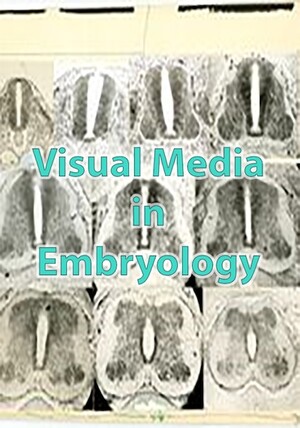Working at the MBL in the late 1880s and 1890s, E.B. Wilson and Edwin Grant Conklin were among the first embryologists to look closely at cellular events in early embryos. By following the lineage of every cell from the single-cell stage to the larval stage, Wilson and Conklin demonstrated that in several species of marine snails and worms entire organs and tissue types arose from individual or small groups of cells in the early embryo.
To accomplish this, they produced hundreds of drawings of embryos at various stages with the aid of a camera lucida. Made up of a series of mirrors that attaches to a microscope, a camera lucida allows specimens seen through the eyepiece to essentially be traced. The process of creating these drawings and the drawings themselves helped Wilson and Conklin to thoroughly observe each specimen and keep track of the behavior of individual cells. Because they worked primarily from slides of fixed and stained embryos, these drawings also played a crucial role in their ability to see cell behaviors in the first place. Wilson and Conklin could infer cellular divisions or movements by comparing drawings of similarly staged embryos and detecting the differences between them.
Once they traced cells and worked out lineages, Wilson and Conklin prepared final drawings that were sent off to lithographers to be copied onto plates and printed. In each their comprehensive publications, Wilson and Conklin described cell lineage in Nereis and Crepidula, respectively, with dozens of full color illustrations.
Seeing with Multiple Mediums
- Landecker, H. (2006). Microcinematography and the History of Science and Film. Isis, 97(1), 121–132. http://doi.org/10.1086/501105
- Brauckmann, S. (2011). Cultures of seeing embryos and cells in 3-dimensions and flatness. Studies in History and Philosophy of Biological and Biomedical Sciences, 42(4), 365–367. http://doi.org/10.1016/j.shpsc.2011.07.010
- Brauckmann, S. (2012). On Fate and Specification: Images and Models in Developmental Biology. In N. Anderson & M. R. Dietrich (Eds.), The Educated Eye: Visual Culture and Pedagogy in the Life Sciences (pp. 213–234). Dartmouth College Press.
- Maienschein, Jane. 1991. “From Presentation to Representation in E. B. Wilson’s The Cell.” Biology and Philosophy 6 (2): 227-54.
Staging Development
- Hamburger, Viktor and Howard L. Hamilton. (1951). “A Series of Normal Stages in the Development of the Chick Embryo.” Journal of Morphology 88(3): 49-92.
- Hopwood, N. (2005). Visual Standards and Disciplinary Change: Normal plates, Tables and Stages in Embryology. History of Science, 43, 239–303.
Looking at Cells
Wilson and Conklin: Tracing Cell Lineages
- Conklin, E. G. (1897). The Embryology of Crepidula: A Contribution to the Cell Lineage and Early Development of Some Marine Gasteropods. Journal of Morphology, 13(1), 1–226.
- B. Wilson, E. (1892). The cell-lineage of Nereis: A contribution to the cytogeny of the annelid body. Journal of Morphology, 6(3), 361–481.
Holtfreter: Observing Cells
- Holtfreter, Johannes. (1943). “A study of the mechanics of gastrulation Part I.” Journal of Experimental Zoology 94: 261-318.
- Holtfreter, Johannes. (1944). “A study of the mechanics of gastrulation Part II.” Journal of Experimental Zoology 95: 171-212.
- Hamburger, Viktor. (1996). “Introduction: Johannes Holtfreter, Pioneer in Experimental Embryology.” Developmental Dynamics 205: 214-216.
- Gerhart, John. (1998). “Johannes Holtfreter: January 9, 1901–November 13, 1992,” Biographical Memoirs National Academy of Sciences 73: 209–28.
Trinkaus: Filming Embryos
- Trinkaus, John Philip. "Surface activity and locomotion of Fundulus deep cells during blastula and gastrula stages." Developmental Biology 30 (1973): 68–103.
- Trinkaus, John Philip. "The yolk syncytial layer of Fundulus: Its origin and history and its significance for early embryogenesis." Journal of Experimental Zoology 265 (1993): 258–84.
Experimenting on Embryos
Exogastrulas
- Gerhart, John. (1998). “Johannes Holtfreter: January 9, 1901–November 13, 1992,” Biographical Memoirs National Academy of Sciences 73: 209–28.
Transplating Limb Buds
- Allen, Garland E. (2004). “A Pact with the Embryo: Viktor Hamburger, Holistic and Mechanistic Philosophy in the Development of Neuroembryology, 1927-1955.” Journal of the History of Biology 37: 421-474
- Hamburger, Viktor. (1934). ‘‘The Effects of Wing Bud Extirpation on the Development of the Central Nervous System in Chick Embryos.’’ Journal of Experimental Zoology 68: 449–494.
- Hamburger, Viktor. (1938). ‘‘Morphogenetic and Axial Self-differentiation of Transplanted Limb Primordia of Two-day Chick Embryos.’’ Journal of Experimental Zoology 77: 379–397

